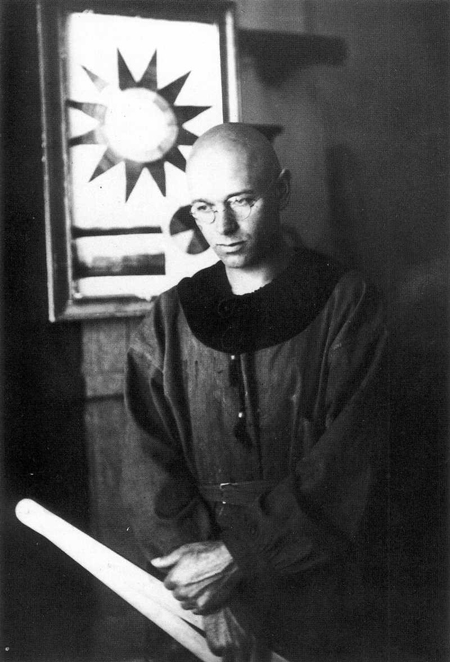













INTRODUCTION | DOCUMENTS | IMAGES | MAPS | EDITOR
|
Johannes Itten (1888-1967) was a Swiss painter, art pedagogue, and color theorist who developed, and then led, the influential preliminary course [Vorkurs] at the Bauhaus. The preliminary course, which introduced students to the basics of form, composition, materials, and color, was among the most widely copied aspects of the Bauhaus curriculum. Undoubtedly the most mystical figure associated with the Bauhaus, Itten was interested in Eastern philosophy, meditation, and the Mazdaznan cult. He was also interested in color, which, for him, had a strongly spiritual dimension. In the photograph below, he stands in front of his Color Sphere in 7 Light Values and 12 Tones [Farbenkugel in 7 Lichtstufen und 12 Tönen], which was published in 1921 in the almanac Utopia: Documents of Reality [Utopia: Dokumente der Wirklichkeit]. Although Itten was extremely popular with his students, his esoteric and spiritual approach to art began to irritate Bauhaus founder Walter Gropius, who wanted to move the school in the direction of rationalism, objectivity, and mass production. Itten left the school in 1923. He was replaced by Lázló Moholy-Nagy, who, along with Itten's former student Josef Albers, took over the preliminary course. Itten’s departure marked a break in the history of the Bauhaus; it spelled an end to the school’s more Expressionist early period and signaled a move toward the greater integration of art and technology. In 1926, Itten founded his own art school in Berlin; it was eventually shut down by the Nazis.
© 2012 Artists Rights Society (ARS), New York / ProLitteris, Zürich |
 print version
print version return to image list
return to image list previous image
previous image
